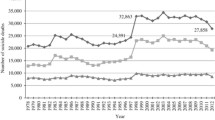Abstract
Suicide prevention programs at a national level in developed countries were briefly reviewed, and the community-based suicide prevention programs in Akita Prefecture, in the Tohoku Region of Japan, were also outlined. Suicide prevention programs were proposed in Western countries in the 1980s. A famous example is the national prevention program in Finland that was started in 1986. The national suicide prevention programs in Western countries share some common features such as their comprehensiveness and diversity. Typical policies of suicide prevention programs were categorized according to primary, secondary and tertiary prevention. Regarding community-based suicide prevention programs using a health promotion approach, the Akita prefectural government incorporated a suicide prevention program into the local health promotion strategy “Health Akita 21” in 2001. An outline of the four action programs was as follows: to raise awareness of suicide prevention, to increase opportunities for mental health consultation, to promote both primary and secondary prevention of depression, and to create a supportive environment for mental health promotion. Community-based suicide prevention programs were started in some communities of model projects that are financially supported by Akita Prefectural government. Efforts to evaluate the effectiveness of community-based suicide prevention programs are needed in the future.
Similar content being viewed by others
References
Kousei Toukei Kyoukai. Trend of National Health. Tokyo: Kousei Toukei Kyoukai, 2001.
Motohashi Y. Local suicide prevention program in Akita prefecture. Challenge of Healthy Akita 21. Medical Practice 2002; 19(6): 1048. (in Japanese)
OECD. OECD Health Data 2002. Paris: CREDES, 2002.
The Planning Committee for the Health Japan 21. The Health Japan 21 (National Health Care Campaign in the Twenty-first Century). Tokyo: Japan Health Promotion and Fitness Foundation, 2000.
Ministry of Health and Welfare. Statistics of suicide. Special Report on Population Dynamics. Tokyo: Kousei Toukei Kyoukai, 1999; 24–25.
Motohashi Y, Ryu Y, Sasaki H. Study on socioeconomic factors and regional differences of suicide in Akita Prefecture. Kousei-no-Sihyou, 1999; 46(15): 105–110. (in Japanese)
Akita Prefectural Government. The Health Akita 21. Akita: Akita Prefectural Government, 2001.
Department of Public Health, Akita University School of Medicine. Report on Baseline Data for Mental Health Promotion in Aikawa Town: Toward Healthy Aikawa 21. Akita: Akita Work Center, 2002.
Taylor SJ, Kingdom D, Jenkins R. How are nations trying to prevent suicide? An analysis of National suicide prevention strategies. Acta Psychiatr Scand. 1997; 95: 457–463.
Hakanen J, Upanne M. Evaluation strategy for Finland’s suicide prevention project. Crisis 1996; 17(4): 167–174.
Nutebaum D, Wise M. Planning for health for all: international experience in setting health goals and targets. Health Promotion Int. 1996; 11: 219–226.
U.S. Department of Health and Human Services. Healthy People 2010: Understanding and Improving Health. 2nd ed. Washington, DC: U.S. Government Printing Office, 2000.
Department of Health of the United Kingdom. The Health of the Nation: A Strategy for Health in England. London: HMSO, 1992.
WHO Regional Office for Europe. Health The health for all policy framework for the WHO European Region. Copenhagen: WHO, 1999.
Hakanen J, Upanne M. Evaluation strategy for Finland’s suicide prevention projects. Crisis 1996; 17: 167–174.
Ministry of Social Affairs and Health of Finland. Government resolution on the Health 2015—public health programme. Helsinki: Edita Plc, 2001.
Secretary of State for Health (UK). Saving Lives: Our Healthier Nation. London: The Stationary Office, 1999.
Department of Health of the United Kingdom. National Suicide Prevention Strategy for England. Consultation Document. London: Department of Health Publications, 2002.
Regier DA, Hirschfeld RM, Goodwin FK, Burke JD, Lazar JB, Judd LL. The NIMH depression awareness, recognition, and treatment program: structure, aims and scientific basis. Am. J. Psychiatr. 1988; 145: 1351–1357.
US Department of Health and Human Services. Healthy People 2000. National Health Promotion and Disease Prevention Objectives. Boston: Jones and Bartlett Publishers, 1992.
National Center for Health Statistics. Highlights of the Healthy People 2000 Final Review. Maryland: U.S. Department of Health and Human Services, 2001.
FNORS. Evaluation de 8 actiions de prévention du suicide. Paris: FNORES, 2000.
L’association Recherche et Rencontres. Programmes nationaux. Stratégie française d’actions face au suicide 2000/2005. www.infosuicide.org/prognat.htm. 2003.
Murata K. Journalists were anguished, and bereaved families were distressed: From the experience of Akita Branch of Asahi-Shinbun. Chuokoron 2001; 4: 112–119.
Akita Branch of Asahi-Shimbun. Suicide. Reports from Akita, prefecture of the highest suicide rate in Japan. Akita: Mumyousya Shuppan, 2000.
The local Government of Akita Prefecture. The Healthy Akita 21. Akita: The local government of Akita Prefecture, 2001.
Takahashi K, Naito H, Morita M, Suga R, Oguma T, Koizumi T. Suicide prevention for the elderly in Matsunoyama town, Higashikubiki county, Niigata prefecture: psychiatric care for elderly depression in the community. Seishin Shinkeigaku Zasshi 1998; 100(7): 469–485.
Ohno Y. Studies on constructing suicide prevention system by epidemiological screening of depression in the community. Tokyo: Department of Psychiatry Keio University School of Medicine, 2000.
Motohashi Y. Study on strategy of suicide prevention by the community participation approach in high suicide rate region. Report of research project by Grant-in-aid for Scientific research of the Ministry of Education, Science and Culture. Tokyo: Akita Work Center, 2003.
Author information
Authors and Affiliations
Corresponding author
Rights and permissions
About this article
Cite this article
Motohashi, Y., Kaneko, Y. & Sasaki, H. Community-based suicide prevention program in Japan using a health promotion approach. Environ Health Prev Med 9, 3–8 (2004). https://doi.org/10.1265/ehpm.9.3
Received:
Accepted:
Issue Date:
DOI: https://doi.org/10.1265/ehpm.9.3




